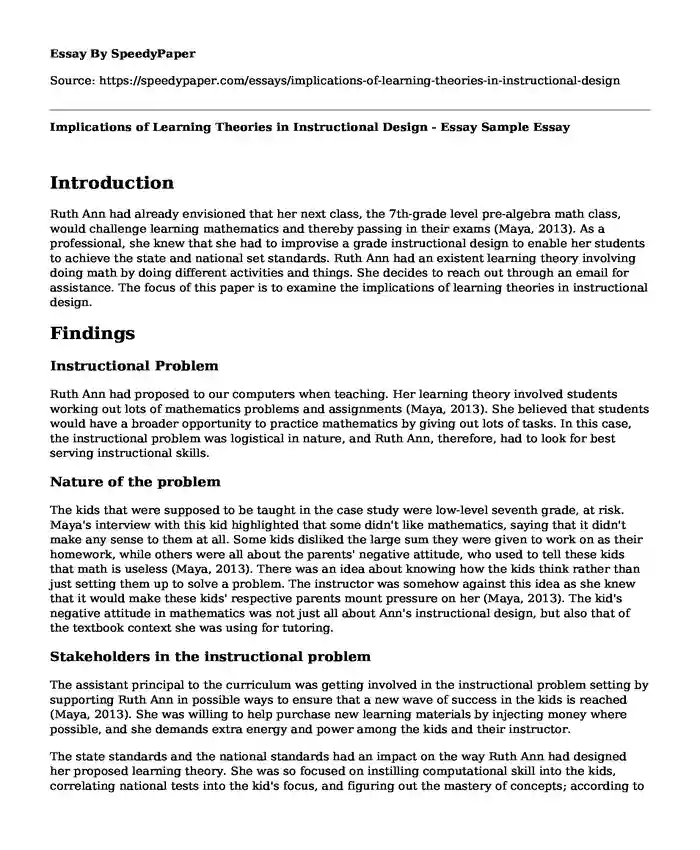Introduction
Ruth Ann had already envisioned that her next class, the 7th-grade level pre-algebra math class, would challenge learning mathematics and thereby passing in their exams (Maya, 2013). As a professional, she knew that she had to improvise a grade instructional design to enable her students to achieve the state and national set standards. Ruth Ann had an existent learning theory involving doing math by doing different activities and things. She decides to reach out through an email for assistance. The focus of this paper is to examine the implications of learning theories in instructional design.
Findings
Instructional Problem
Ruth Ann had proposed to our computers when teaching. Her learning theory involved students working out lots of mathematics problems and assignments (Maya, 2013). She believed that students would have a broader opportunity to practice mathematics by giving out lots of tasks. In this case, the instructional problem was logistical in nature, and Ruth Ann, therefore, had to look for best serving instructional skills.
Nature of the problem
The kids that were supposed to be taught in the case study were low-level seventh grade, at risk. Maya's interview with this kid highlighted that some didn't like mathematics, saying that it didn't make any sense to them at all. Some kids disliked the large sum they were given to work on as their homework, while others were all about the parents' negative attitude, who used to tell these kids that math is useless (Maya, 2013). There was an idea about knowing how the kids think rather than just setting them up to solve a problem. The instructor was somehow against this idea as she knew that it would make these kids' respective parents mount pressure on her (Maya, 2013). The kid's negative attitude in mathematics was not just all about Ann's instructional design, but also that of the textbook context she was using for tutoring.
Stakeholders in the instructional problem
The assistant principal to the curriculum was getting involved in the instructional problem setting by supporting Ruth Ann in possible ways to ensure that a new wave of success in the kids is reached (Maya, 2013). She was willing to help purchase new learning materials by injecting money where possible, and she demands extra energy and power among the kids and their instructor.
The state standards and the national standards had an impact on the way Ruth Ann had designed her proposed learning theory. She was so focused on instilling computational skill into the kids, correlating national tests into the kid's focus, and figuring out the mastery of concepts; according to the state standards to a level that blinded her that the understanding of the way her kids think was equally a critical step in making sure that leaning theory yielded the expected results (Maya, 2013).
Maya's research on the textbook that Jane Ann used brought it off that it was deficient in some ideas (Maya, 2013). Although it had some crucial things like computational study, emphasize topics highlighted by the state standards, and include technology integration, Maya found out that it was not enough to make the students pass. The in the technology part of it, most of these kids had not used computers a lot and were thereby deficient of interest in it.
My Designed Theory of Learning
The best learning approach, in this case, would have been the cognitive approach. The kids here become dynamic agents in the leaning exercise. Prior knowledge in algebra would be necessary, but the instructor should help kids who lack background knowledge (Etmer & Newby, 2013) Motivation amongst the kids and continuous improvement would be evident. A proper approach and a sequential design of tutoring material stand out to be critical in this particular case.
References
Ertmer, P., & Newby, T. (2013). Behaviorism, Cognitivism, Constructivism: Comparing Critical Features From an Instructional Design Perspective. Performance Improvement Quarterly, 26(2), 43-71. https://doi.org/10.1002/piq.21143
Maya, T. (2013). Implementing New Instructional Approaches, A-K12 settinghttps://www.sematicsscholar.org/paper/maya-thomas-%3A-Implementin-new-Instructional-in-Orill-Hill/9124e821a7f9b7971e8880ca5dadeb1e478a
Cite this page
Implications of Learning Theories in Instructional Design - Essay Sample. (2023, Dec 30). Retrieved from https://speedypaper.com/essays/implications-of-learning-theories-in-instructional-design
Request Removal
If you are the original author of this essay and no longer wish to have it published on the SpeedyPaper website, please click below to request its removal:
- IT Admission Essay Sample
- The Humanities Are Not a Luxury - Free Essay with an Article Analysis
- Theory of Knowledge Essay Sample
- Contemporary Society in Application Essay Example
- Diversity - for Scholarship Consideration. Education Essay Example.
- Free Essay: Sears Hometown Goods Training
- Understanding IEP: An Essay Sample on Individualized Education Programs for Children with Disabilities
Popular categories





